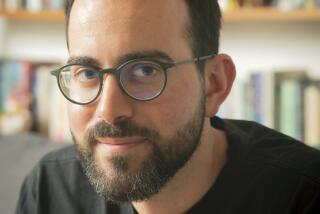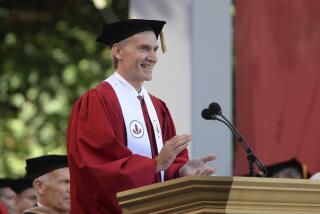Invisible Frontiers: THE RACE TO SYNTHESIZE A HUMAN GENE by Stephen S. Hall (Atlantic Monthly: $19.95; 352 pp.)
- Share via
Some scientists work quietly alone, in academic backwaters, on problems of interest only to themselves, maintaining 9-to-5 hours and placid demeanors. But while their work may animate them, it’s not apt to provide much grist for the new crop of Real Science books that seek to convey the excitement, frustration, politics, and rivalries of big-time science. Like their opposite numbers in the arts, business and politics, science writers tend to gravitate toward the luminaries of science, not its rank and file--those tackling big problems that are likely to generate hot passions and fevered competition: big problems-- like the synthesis of a human gene, the subject of Stephen S. Hall’s well-told tale, “Invisible Frontiers.”
Once, “gene” was just a hazy abstraction for the whatever-it-is that makes one person brown-eyed and tall and another blue-eyed and short. In the early 1950s, the carrier of life’s genetic heritage was found to be the molecule DNA, whose structure was shown capable of storing biological information and passing it down through the generations; a gene, then, is a discrete stretch of DNA. In the 1970s, the new recombinant DNA technology made conceivable the actual synthesis, from scratch, of a human gene.
Three hotly competitive research groups at either end of the continent embarked on the project. One was directed by future Nobel laureate Walter Gilbert of Harvard. A second, at the University of California at San Francisco, was under William Rutter and Howard Goodman. A third at the City of Hope Research Center in Duarte, Calif., soon came under the corporate umbrella of a new biotechnology firm, Genentech, formed by another UCSF lab chief, Herb Boyer.
Their interest centered specifically on the gene that makes insulin, the hormone that breaks down sugar and which diabetics lack. At the time, commercial insulin was made exclusively from cow and pig pancreases; it differed slightly from human insulin, and some diabetics were allergic to it. Then, too, a decline in consumer demand had depressed the meat industry and begun to suggest the specter of insulin shortages. Making human insulin in bacterial factories into which had been inserted the human insulin gene might be a way to churn out virtually unlimited quantities of the stuff. No shortages. No allergies. And cheap.
This, at any rate, was the public rationale for the great project. But as Stephen S. Hall makes clear, the official and public version of scientific events, as told in press releases and newspaper accounts, normally bears but slight resemblance to the emotional and human truth of what really goes on.
Based on more than 150 interviews, Hall tells the truth.
He reconstructs the early days of the genetic engineering revolution. He tells of powerful commercial interests staking out claims for a piece of the biotechnology action, pumping in money, raising the stakes. He tells of lab chiefs taking credit for discoveries by their students about which they knew little. Of normally lab-bound researchers trying to explain and justify their recombinant DNA work, then mired in controversy, to scientifically illiterate inquisitors. Of the Harvard lab’s underground lab newsletter, the Midnight Hustler, with its insouciant perspective on the East Coast-West Coast competition. Of two Genentech scientists fishing out on the pier behind their South San Francisco lab in the dead time between experiments.
Hall, who says he was a liberal arts student in college and took little science, warns that he’s told his scientific story “at a level of detail that may at first be . . . alarming to the general reader.” In fact, most readers, at least those with even a minimal grounding in science, needn’t worry. Hall has used his ignorance as a writing tool, allowing him to jump over conceptual obstacles the professional scientist might no longer even see. Indeed, he’s gone even good science writing one better, rendering clear not just the science itself, but scientific methodology. So that when the little bands show up just right on the electrophoresis gels, the reader shares the scientist’s delight.
Less successful is Hall’s unraveling of the story’s human complexity. There are just too many characters, too many competing interests, to keep straight without skills of compression and concision, highlighting and shadowing, more extraordinary than the author can muster. The reader faces not just the three main lab groups, each with their dozen or so players, but various camps within each. And associated with each are the commercial interests. The Harvard group is linked to a new company, Biogen. The insulin manufacturer, Eli Lilly, maintains links to two of the labs. The third company, Genentech, as noted, has ties with both UCSF and City of Hope.
Perhaps mindful of the problem, Hall (or his editors) furnishes a Dramatis Personae of the three dozen or so leading characters; the reader will turn to it more than to his old college biology textbook. But it’s not enough; too often, the names never become more than names. By book’s end, after more than 300 pages, only four or five figures linger in the mind as real people, the rest sinking in a murky sea of faceless quotes. One wishes for fewer characters each better drawn.
Then, too, the reader sometimes suspects that those four or five are not invariably the key actors in the drama but those who most fully opened up to the author, as interview subjects. The result is a nagging suspicion that our view of these complex and variegated events is mildly skewed--skewed toward the young men and women at the bench, rather than to the lab chiefs. As if we were being told of a battle from the perspective of foot-slogging GIs not always best situated to see what’s going on. (Of course, it may be said, this merely redresses an old imbalance: Stories of science are usually skewed too much toward the scientific generals.)
In the end, what sticks in the reader’s mind is not so much the science, as fascinating and expertly told as it is; and even less the individual personalities of the scientists. Rather, it is the labs, as both physical entities and social organisms, with their own chemistry, with minds and souls of their own--like Army platoons, or corps de ballet, or boards of trustees. Or human families.






